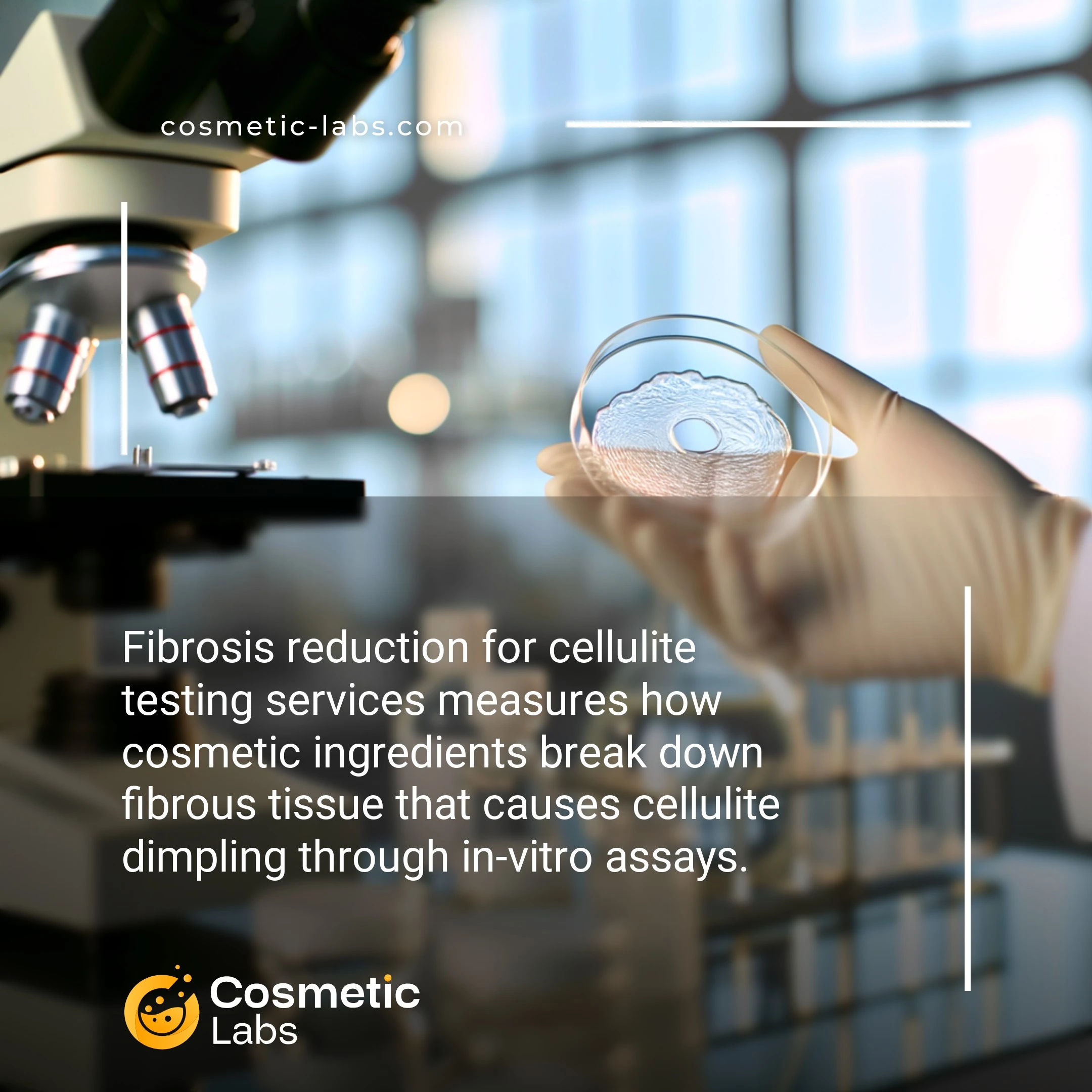Fibrosis Reduction Testing for Cellulite Treatment Products

What is Fibrosis reduction?
Fibrosis reduction testing for cellulite is a specialized preclinical assessment that measures how cosmetic ingredients and formulations break down fibrous tissue bands beneath the skin. Labs use ex-vivo skin models and collagenase activity assays to evaluate active compounds like retinoids, peptides, and botanical extracts for their ability to soften connective tissue structures that contribute to cellulite’s dimpled appearance.
Why do you need this service?
Cosmetic labs use fibrosis reduction testing protocols to validate anti-cellulite formulations before market launch, measuring collagen remodeling and skin texture improvements through histological analysis and biomechanical assessments. Beauty brands rely on these services to generate clinical evidence for marketing claims, supporting product positioning and regulatory compliance while reducing costly reformulation cycles during development phases.
Who provides Fibrosis reduction services?
All cosmetic labs providing Fibrosis reduction services
There is no company providing these services at the moment.
Fibrosis Reduction Testing for Anti-Cellulite Products
Fibrosis reduction testing measures how effectively your anti-cellulite formulations break down the fibrous connective tissue that creates dimpled skin appearance. This specialized testing validates your product’s ability to target the structural components of cellulite formation.
Collagen Remodeling Assessment
Labs evaluate your formulation’s impact on collagen synthesis and degradation pathways. Testing protocols examine matrix metalloproteinase activity and collagen fiber organization changes over treatment periods.
Key measurements include:
- Collagen I and III expression levels
- Elastin fiber density changes
- Hyaluronic acid content variations
- Fibroblast proliferation rates
These assessments help you document your product’s ability to improve skin texture and firmness through targeted tissue remodeling.
Connective Tissue Flexibility Analysis
Testing measures how your formulation affects the mechanical properties of dermal connective tissue. Labs use biomechanical testing to evaluate changes in tissue elasticity and tensile strength.
Standard evaluation methods:
- Tissue extensibility measurements
- Stress-strain relationship analysis
- Viscoelastic property assessment
- Dermal thickness monitoring
This data supports claims about improved skin smoothness and reduced cellulite appearance. Connect with specialized cosmetic labs on our platform to discuss your anti-cellulite testing requirements and validation needs.
Practical Applications of Anti-Fibrotic Cellulite Testing Services
Beauty brands rely on fibrosis reduction testing for cellulite treatments to validate product claims and demonstrate measurable skin improvement before market launch.
Product Development and Claim Validation
Labs use histological analysis and collagen fiber measurement to assess how ingredients break down fibrous septae that create cellulite’s dimpled appearance. Testing protocols examine dermal thickness changes, elastin fiber organization, and subcutaneous fat layer modifications over 28-90 day periods.
Brand teams submit formulations containing retinoids, peptides, or botanical extracts for quantitative fibrosis assessment using specialized imaging techniques. Results provide data for regulatory submissions and marketing claims about skin smoothness improvement.
Ingredient Screening and Formulation Optimization
Cosmetic labs evaluate raw materials through in-vitro fibroblast culture studies and ex-vivo skin models to identify compounds that inhibit excessive collagen production. Testing measures matrix metalloproteinase activity, TGF-β pathway modulation, and cellular response to anti-fibrotic agents.
Manufacturers use concentration-response data to optimize active ingredient levels and delivery systems. Labs test penetration enhancers, liposomal encapsulation, and topical formulation matrices to maximize anti-fibrotic efficacy while maintaining skin compatibility.
| Testing Method | Measurement Focus | Timeline | Key Metrics |
|---|---|---|---|
| Histological Analysis | Collagen fiber density | 4-12 weeks | Septae thickness, dermal organization |
| Ultrasound Imaging | Skin layer structure | 2-8 weeks | Dermal thickness, echogenicity changes |
| Biochemical Assays | Enzyme activity | 24-72 hours | MMP levels, collagen synthesis markers |
| Cell Culture Studies | Fibroblast behavior | 7-21 days | Proliferation rates, protein expression |
Ready to validate your cellulite treatment formulation? Connect with specialized cosmetic testing labs on our platform to discuss your anti-fibrotic testing requirements and timeline.
